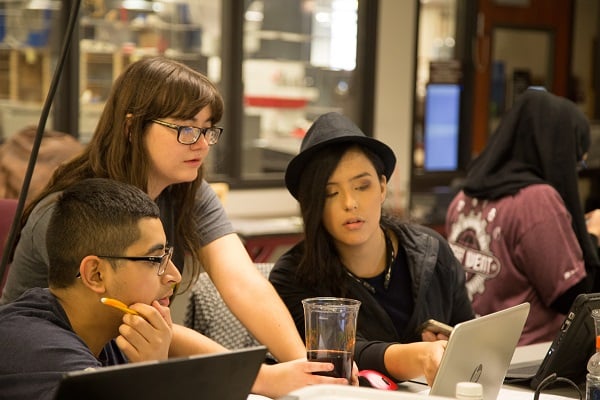Published on
Engineering Academies: An Innovative Model to Address Three Challenges At Once

Colleges and universities across the United States are under increasing pressure from all sides to improve access—including transfer—to drive student persistence and outcomes, and finally to prepare them for successful careers. While many institutions have identified ways to address one, or even two, of these goals, managing to successfully address all three (access, outcomes, career success) has been rare. In Texas, however, they seem to have found a way. Texas A&M’s Engineering Academies model has the College of Engineering partnering with community colleges across the state to create access pipelines for two-year students to transfer, upon completion of their associate’s degree, to College Station to complete their engineering degree, which prepares these learners for careers in a high-demand field. In this interview, Jackie Perez reflects on what it took to launch this model and shares her thoughts on how she hopes to see it expand.
The EvoLLLution (Evo): What were some of the factors that led to the creation of the Engineering Academies model?
Jackie Perez (JP): The College of Engineering at Texas A&M University recognized the increasing demand for access to an Aggie Engineering degree, the increasing percentage of students starting higher education at a two-year institution, and the increasing demand for engineers entering the workforce. In addition, we recognize that two-year colleges are enrolling and serving an increasingly diverse population. This is critical since industry is engaged in efforts to increase ingenuity and drive innovation by diversifying the workforce and employing skilled professionals that are more representative of the communities they serve.
The Texas A&M Engineering Academies are innovative pathways for students seeking to pursue a degree from the Texas A&M University College of Engineering. The Academies model recognizes the significant role that two-year institutions play in educating the engineering workforce of tomorrow.
The Academies have three overarching goals:
- Expand accessibility to an Aggie engineering degree
- Increase affordability of an Aggie engineering degree
- Contribute to the technologically trained workforce in Texas
The Academies allow students an opportunity to co-enroll in the College of Engineering at Texas A&M University and a partner two-year institution—this means the students are Texas Aggies from day one. Students stay co-enrolled for one to two years before transitioning to Texas A&M University’s College Station campus to complete their bachelor’s degrees.
The Academies started in 2015 with Blinn College-Brenham. Funding from Chevron allowed us to expand the educational opportunity—highlighting industry investment in expanding pathways for students from diverse backgrounds—and launch partnerships across Texas starting in 2015 with Houston Community College, 2016 with El Centro College in Dallas, 2017 with Austin Community College and Texas Southmost College in Brownsville and 2018 with Alamo Colleges in San Antonio. The Chevron Academies provide an opportunity for students to begin their Aggie engineering degree close to home.
The Engineering Academies are also contributing to the College of Engineering’s 25 by 25 program—a transformational education program designed to increase access for qualified students to pursue engineering education at Texas A&M University and increase total enrollment to 25,000 students by 2025. This includes students at our College Station, Galveston, Qatar and McAllen campuses, as well as online master’s degree students and students in the statewide Engineering Academies.
Evo: What were a few of the major roadblocks you faced in getting the program off the ground, and how did you overcome them?
JP: Across the state and nation, educators are implementing programs and articulation agreements to support the success of transfer students. Chevron’s support provided an opportunity to expand to institutions as far south as Brownsville, seven hours away from Texas A&M University.
However, the co-enrolled, industry-sponsored, approach—where faculty from the four-year institution teach engineering-specific courses on the two-year institution campus—is brand new. We had no roadmap to guide us as we developed these new, wonderfully robust partnerships where students adhere to the requirements of both institutions.Student access to university advisors, student services, engineering professional development events and entrepreneurship programs is crucial to the success of the program and helps students identify as Texas Aggies while they are co-enrolled, but it takes a lot of intentionality on the parts of many departments at all the partnering institutions to make it work.
Our partnering institutions have been instrumental in launching the Engineering Academies as we bring together dedicated professionals who are committed to student success. Our team is committed to providing clear pathways for an increasing number of students that otherwise may have never considered an Aggie engineering degree as a possibility.
Evo: Since launching this model, what have been a few of the critical lessons you and your colleagues have learned?
JP: Texas residents enrolled in one of the Texas A&M Engineering Academies save an average $3600 per semester in tuition and fees compared to an engineering student enrolled full time at Texas A&M University in College Station. Despite the savings, students and their families are still finding it difficult to pay for the tuition and fees for their Texas A&M engineering coursework while they are co-enrolled. Over 60 percent of students in the Academy at Houston Community College in 2015 had demonstrated financial need and many of the students were working 30+ hours a week.
Furthermore, the 60x30TX Higher Education Plan states, “In 2013 Texas ranked 23rd in the U.S. in the percentage of undergraduate students considered economically disadvantaged, a population projected to grow.” The report concludes that reducing student debt will “lead to healthier individual finances among graduates and a stronger state economy.” Securing scholarships for engineering students in the Academies is an essential component to student retention and to reducing student debt at graduation.
Evo: How do you expect to see this model continue to evolve at Texas A&M?
JP: By fall 2018, Texas A&M will have six remote Academy partnerships. One with Blinn College-Brenham and the five Chevron-supported Academies in Austin, Brownsville, Dallas, Houston, and San Antonio. The students admitted can pursue any one of the 18 bachelor’s degree programs from the Texas A&M College of Engineering just like their peers that start their postsecondary education on the Texas A&M University campus.
The Engineering Academies, combined with our additional local partnership with Blinn College–Bryan, are positioned to further expand impacts resulting in:
- Up to 1000 new students each academic year;
- Enhanced community college completion rates; and
- An increasing number of engineering graduates.
Evo: Looking more broadly, do you expect to see this model become more common nationwide?
JP: It is well known that the cost of tuition and fees at community colleges is significantly lower than the tuition and fees at four-year institutions, making the transfer route a more appealing pathway for so many students. According to the Digest of Education Statistics, in 2013, over 17 million students were enrolled in U.S. public or private academic institutions with over 6 million enrolled at two-year institutions; Texas ranked second in the nation in both two- and four-year enrollment. Furthermore, data from the National Student Clearinghouse Research Center showed that in 2012, Texas lead the nation with over 78 percent of students graduating with a four-year degree who were previously enrolled at one or more two-year institutions. This exceeded the national average of 45 percent. I believe that increasing access and affordability of a four-year degree should be one of the priorities of all public institutions of higher education.
I also believe this model can be scaled and replicated across the country where two- and four-year institutions can partner and increase pathways for their students. Unlike traditional transfer articulation agreements, students in a Texas A&M Engineering Academy earn Texas A&M engineering course credit taught by Texas A&M engineering faculty on the two-year campus. The students are earning measurable progress toward a bachelor’s degree while completing an associate degree.
Understandably, institutions will evaluate their workforce needs and have to work within the guidelines of their state policies. Industry can positively influence the success of creating these partnerships and in return, actively play a role in educating the next generation of engineers from diverse backgrounds and life experiences. We are certainly proud that Texas A&M University, the Texas A&M College of Engineering, Chevron and each of our partner institutions recognize the importance and value of creating, evaluating and sustaining these partnerships.
Author Perspective: Administrator



